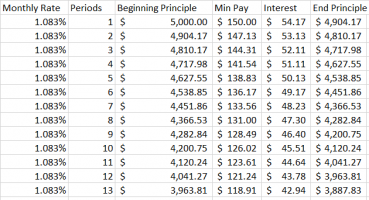Jebediahstewart34
New member
- Joined
- Nov 17, 2021
- Messages
- 4
I understand there are very simple formulas to calculate the nper if you have a defined interest rate, PV, FV and PMT. I'm running into an issue however in a scenario with a variable payment amount (e.g. the payment is either 3% of the balance or $25, whichever is greater).
I know I can build out an amortization schedule and simply count the number of periods until FV ends up hitting 0, but is there a formula I can use to get the same result? I'll continue trying to a spreadsheet with the amort table momentarily, having issues getting it to attach.
EDIT: I adjusted the payment scenario noted above to ensure the balance would reduce with each min pay. It also appears I'm unable to attach a spreadsheet. Not sure if that's user error or not, but it's a simple spreadsheet with columns of Monthly Rate, Period, Beginning Principle, Min Pay, Interest and End Principle. It simply calculates each of those fields for each subsequent period until the End Principle gets to $0, which then shows how many periods it took to get there.
I know I can build out an amortization schedule and simply count the number of periods until FV ends up hitting 0, but is there a formula I can use to get the same result? I'll continue trying to a spreadsheet with the amort table momentarily, having issues getting it to attach.
EDIT: I adjusted the payment scenario noted above to ensure the balance would reduce with each min pay. It also appears I'm unable to attach a spreadsheet. Not sure if that's user error or not, but it's a simple spreadsheet with columns of Monthly Rate, Period, Beginning Principle, Min Pay, Interest and End Principle. It simply calculates each of those fields for each subsequent period until the End Principle gets to $0, which then shows how many periods it took to get there.
Last edited:

